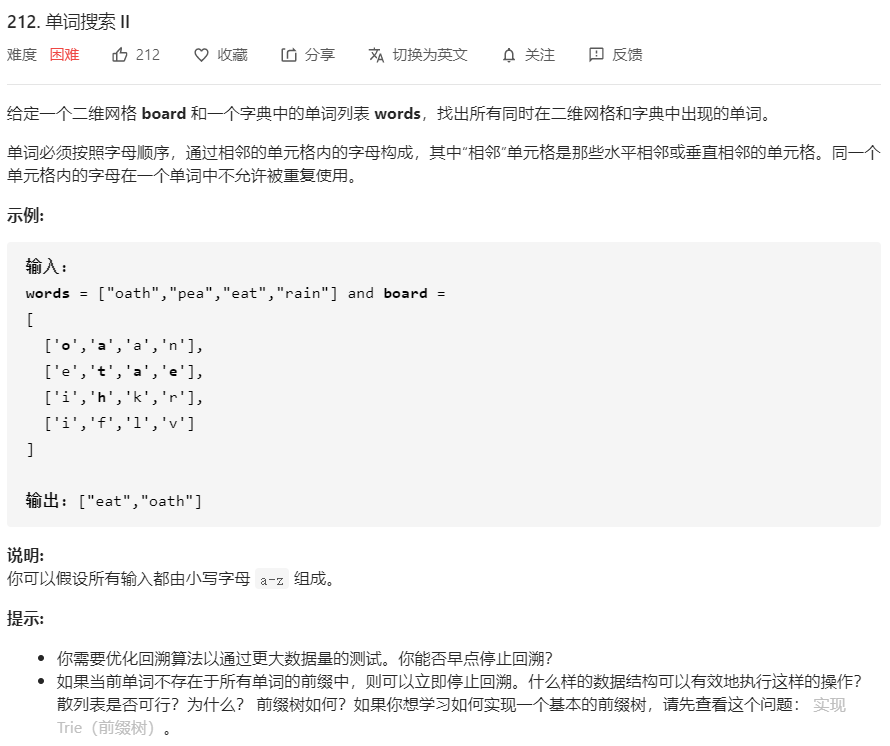
这题是LeetCode79. 单词搜索的进阶版,第79题是在二维的char数组里搜索单个单词,
这题需要在二维char数组里搜索一组单词。
理论上只需要对遍历单词数组,逐个套用79的dfs方法即可,不过这题题目要求了需要用Trie树做优化。
所以,我们最开始可以把单词列表里的所有单词都插入到一个Trie树中,然后对单词做搜索的时候,除了检查下一个位置的字母不越界且未使用过(题目要求
同一个单元格内的字母不允许被重复使用)以外,还需要检查下一个位置的字母是否是当前字母在trie树的孩子。
通过这个额外的Trie树的剪枝,可以减小搜索空间。
有几点需要注意:
(1)Trie树存储每个单词的时候,需要在每个单词的结尾字母打一个标记,我们用一个整数变量id来确定当前字母是第id个字母(id从0开始)的结尾。
id就是单词在words列表中的顺序。 我们在dfs的时候,成功搜索到单词的标志就是最终的指针指向的字母的id不为-1(构造函数中对id初始赋值为-1)。
(2)我们可能会在char数组中多次搜索到同样的单词,所以需要额外用一个哈希表unordered_set来对dfs函数搜索到的单词的id进行记录。
(3)我们把二维char数组board记录到一个全局二维char变量g中,并用全局变量rows和cols记录二维数组的行数和列数,这样dfs函数可以少传几个参数。
代码如下:
class Solution {
public:
vector<vector<char>> g; //记录二维字符数组
int rows, cols, dx[4] = {0, 1, -1, 0}, dy[4] = {1, 0, 0, -1}; //g的行数、列数、dfs的四个方向
unordered_set<int> ids; //用来去重
struct Node { //Trie树的节点
int id;
Node *son[26];
Node() {
id = -1;
for(int i = 0; i < 26; ++i) {
son[i] = NULL;
}
}
}*root;
void insert(string &word, int id) { //在Trie树中插入单词,并在结尾记录id
Node *p = root;
for(int i = 0; i < word.size(); ++i) {
int u = word[i] - 'a';
if(p -> son[u] == NULL) {
p -> son[u] = new Node();
}
p = p -> son[u];
}
p -> id = id;
}
void dfs(int x, int y, Node *p) {
if(p -> id != -1) { //搜索成功一个单词,在哈希表ids中记录id
ids.insert(p -> id);
}
char temp = g[x][y]; //题目要求同一个单元格内的字母在一个单词中不允许被重复使用,所以我们先记录下这个位置的字符,然后暂时将他修改为'.',表示不可用,dfs之后再恢复现场
g[x][y] = '.';
for(int i = 0; i < 4; ++i) {
int newX = x + dx[i], newY = y + dy[i];
if(newX >= 0 && newX < rows && newY >= 0 && newY < cols //如果下一个位置不越界
&& g[newX][newY] != '.' && p -> son[g[newX][newY] - 'a'] != NULL) { //且下一个位置未被使用过(g[newX][newY] != '.'),且在Trie树中下一个字母是当前字母的孩子
dfs(newX, newY, p -> son[g[newX][newY] - 'a']); //继续搜索
}
}
g[x][y] = temp; //恢复现场,把这个位置的字母从'.'恢复到它本来的样子
}
vector<string> findWords(vector<vector<char>>& board, vector<string>& words) {
vector<string> res;
g = board;
rows = g.size(), cols = g[0].size();
root = new Node();
for(int i = 0; i < words.size(); ++i) { //把所有单词插入到一个Trie树中
insert(words[i], i);
}
for(int i = 0; i < rows; ++i) {
for(int j = 0; j < cols; ++j) {
int u = g[i][j] - 'a';
if(root -> son[u] != NULL) { //如果当前字母是Trie树根节点的孩子,说明从当前位置搜索单词可能有戏
dfs(i, j, root -> son[u]); //开始搜索
}
}
}
for(auto id : ids) { //去重之后,我们就知道哪些单词搜索到了,把这些搜索到的单词加入到结果数组res中
res.push_back(words[id]);
}
return res;
}
};